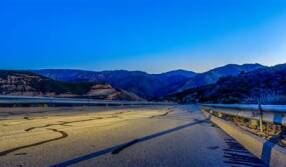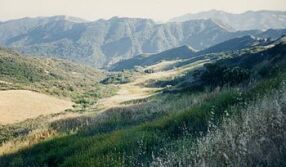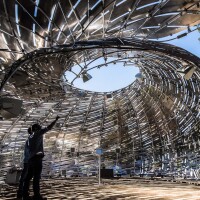8 of the Best Places to See the Night Sky in L.A. County

When it comes to reliably clear skies with a minimum of light pollution, it's hard to beat the eastern California desert. But let's face it: those of us who live in urban Southern California can't always just pick up and head for the outback when we want to see a star. Fortunately, there are a few places closer at hand in L.A. County where the night skies are dark enough to make tilting your head upward worthwhile. And some spots aren't so dark, but are worth checking out anyway for the expert stargazing companionship to be found there.
1. Templin Highway, Angeles National Forest
The Templin Highway stargazing area has long been a popular spot among amateur astronomers. It's accessible, only 45 minutes from downtown (assuming nighttime traffic) and less than a mile from Interstate 5 near Castaic. Take Templin Highway .7 miles east from "The 5" until you spy a wide gravel pulloff on the right, sheltered by a ridge from some of the Interstate's headlight glare. (During popular meteor shows and other events, you'll often see a crowd gathered when you arrive: use your lowbeams as you park lest you blind your new stargazing buddies.) All this just a few minutes from the comforts of Castaic.
2. Saddleback Butte State Park, Antelope Valley
Saddleback Butte State Park is an unsung gem in L.A. County's desert, and though its skies are not as dark as they were 20 years ago with Lancaster and Palmdale slowly growing 15 miles west, it's still a great place to reacquaint yourself with the Milky Way and other dark sky wonders. The park's closes for day use at sunset, but 50 campsites are available on a first-come, first-served basis, and the campsites offer abundant great spots to set up a — or just to lie back in a reclining chair with a naked pair of eyes. Its visitor is also closed.
3. Antelope Valley Poppy Reserve, Antelope Valley
Antelope Valley Poppy Reserve seems like an obvious spot for L.A. County stargazing, what with its being out in the middle of nowhere in the desert, and yet just an hour and a half from downtown Los Angeles. At least that's what your correspondent was thinking a few years back when he took a date out there to watch the Perseids, only to find the parking lot chained off, as it is most days at sunset. But Antelope Valley stargazers have a secret: every so often, the Antelope Valley Astronomy Club works with California State Parks to keep that chain open so that they can hold star parties in the parking lot, usually as a benefit for the state parks. The club holds star parties elsewhere north of Los Angeles, as well: check out their website for updates. If you don't find a star party, the intersection of Lancaster Avenue and 160th St. W, a dirt road at the west edge of the Reserve, has a wide shoulder you can use.
4. Topanga State Park, Santa Monica Mountains
Closer to downtown, the Santa Monica Mountains offer some remarkably dark skies considering that the mountain range is hemmed in by the San Fernando Valley and the L.A. Basin. The range's skies get darker the farther west you go, but even more eastern sites like Topanga State Park can offer some good meteor-watching on nights with clear skies. Topanga has a campground for those stargazers intent on watching that big star come up in the east.
5. Malibu Creek State Park, Santa Monica Mountains
A bit west of Topanga, and thus with a slightly darker sky, Malibu Creek State Park is another popular stargazers' hangout. Like Topanga, Malibu Creek has camping spots available but in case you'd rather sleep in your own bed, Malibu Creek's Upper Parking Lot is a popular spot for casual stargazing as well.
6. Mount Wilson, Angeles National Forest
You can always use Mount Wilson. I don't mean the Observatory, though you can rent its 100-inch telescope for a considerable chunk of change. I mean the mountain itself: use it as a blind to block most of the light coming from the San Gabriel Valley. The Angeles Crest Highway/Route 2 winds its way from La Cañada to Wrightwood just north of Mount Wilson, and there are lots of wide turnouts you can use for stargazing. Especially good ones can be found in the stretch east of Upper Big Tujunga Canyon Road.
7. Pasadena, Monrovia, and Eagle Rock
Okay, so you don't have the car this week and can't get out to Malibu or the Antelope Valley. All is not lost: you can still see a few astronomical objects from the streets of the western San Gabriel Valley. The Old Town Sidewalk Astronomers set up scopes on clear Friday and Saturday nights in Pasadena and Monrovia, respectively, assuming there's something in the sky that can shine through the bright gray night sky generally found in the 626. That usually means the Moon, Jupiter, or Saturn. The group sends out email alerts when they plan to set up on local sidewalks: you can join the list at their website (If you never venture east of Eagle Rock, the Los Angeles Sidewalk astronomers engage in similar activities west of the L.A. River).
8. Griffith Observatory, Griffith Park
Even though the western end of the Santa Monica Mountains is far darker, there's a spot all the way at the brightly lit east end of the range that's not a bad place for urban stargazing, and it's easy to find: there's an observatory right there. The Griffith Observatory offers free, public star parties each month which run until 9:45 p.m., which means it's not too late for a school night for the kids. Public star parties, however, are currently on hiatus.
Note: This article has been updated August 10, 2021. Please check the status of all recommended areas before heading out.













